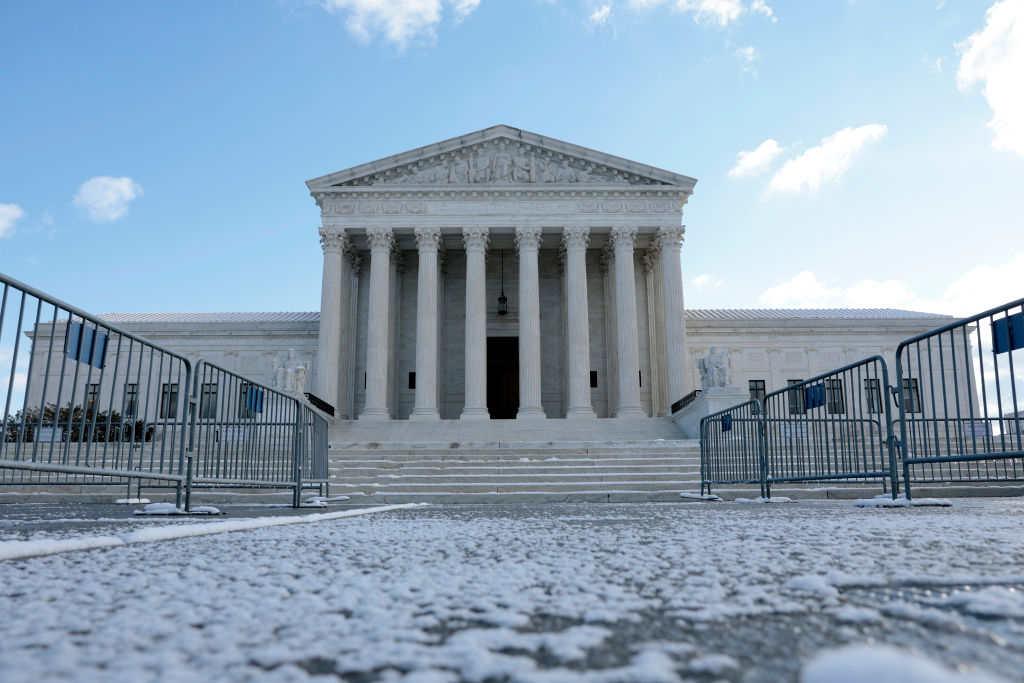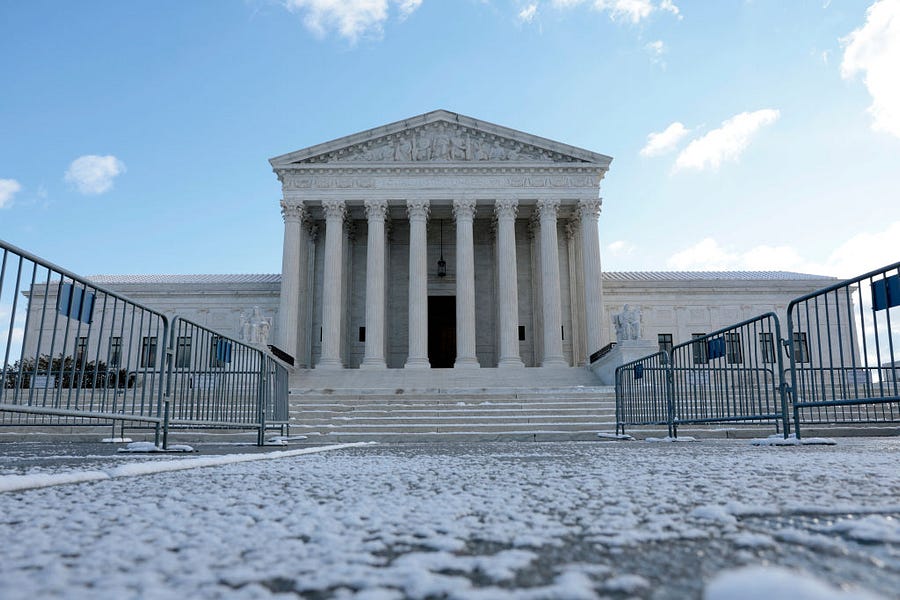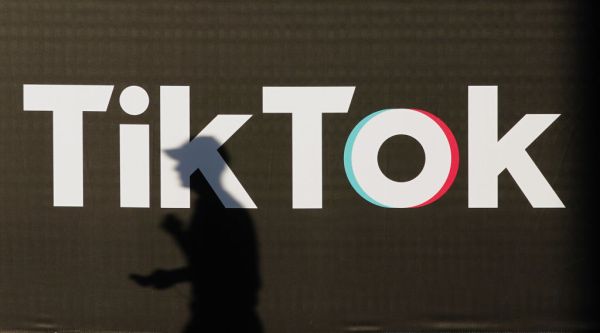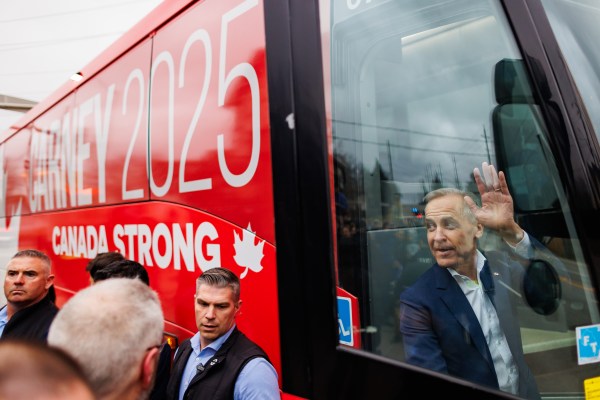Happy Monday! He is by all accounts a great guy and has handled a tough situation with class, but if Matt Nagy is still the head coach of the Chicago Bears by this afternoon, prepare for some nuclear hot takes in tomorrow’s TMD.
Quick Hits: Today’s Top Stories
-
The Bureau of Labor Statistics reported Friday that U.S. employers added 199,000 jobs in December, while the unemployment rate rate fell from 4.2 percent to 3.9 percent. The labor force participation rate remained unchanged from November at 61.9 percent.
-
Eurozone inflation rose at the fastest year-over-year rate on record in December, with the European Union’s statistics office reporting a 5 percent increase in consumer prices from 12 months prior.
-
President Joe Biden will deliver his first State of the Union address before Congress on March 1—later in the year than is typical.
-
New data published by New York’s Department of Health show that, although the state’s topline COVID-19 hospitalization numbers are near record highs, 43 percent of COVID-positive patients currently hospitalized were admitted for another reason, and only tested positive for COVID-19 incidentally.
-
Citing aid workers in the region, Reuters reported Saturday that forces led by Ethiopian Prime Minister Abiy Ahmed had conducted airstrikes near a camp for displaced people in the country’s Tigray region, leaving 56 people dead and at least 30 others wounded.
-
Authorities in Kazakhstan arrested the former head of the country’s National Security Committee, Karim Massimov, on charges of treason. Massimov’s detention follows a week of anti-government protests and an ensuing crackdown across the country, which have now resulted in at least 164 deaths.
-
After deliberating for months, two Republican Senators—John Thune of South Dakota and Ron Johnson of Wisconsin—announced over the weekend they would seek re-election in 2022.
-
An electric space heater malfunction on Sunday led to New York City’s deadliest fire in decades, with 19 people—including nine children—dying as a Bronx apartment building went up in flames.
-
Superior Court Judge Timothy Walmsley sentenced Travis McMichael, Greg McMichael, and William “Roddie” Bryan—the three men found guilty by a Georgia jury last year of murdering Ahmaud Arbery—to life in prison. While Bryan will be eligible for parole after serving 30 years in prison, the McMichaels received life without parole.
-
In a letter to Democratic Rep. Bennie Thompson, Republican Rep. Jim Jordan made clear he will not cooperate with the January 6 Select Committee’s investigation.
A Tale of Two Vaccine Mandates

When President Biden announced back in September he had ordered the Occupational Safety and Health Administration (OSHA) to draft an emergency rule requiring businesses with 100 or more employees to mandate either COVID-19 vaccines or weekly testing for their workers, it was a pretty safe bet the regulation would eventually end up before the Supreme Court.
After announcing in late December it would expedite its typical process, the Court on Friday heard oral arguments in two separate mandate-related cases: One on the OSHA vaccine-or-testing rule, and another on the Centers for Medicare & Medicaid Services’ (CMS) requirement that—barring medical or religious exemptions—employees at healthcare facilities receiving Medicare and Medicaid funds be fully vaccinated.
A certain line of questioning from Justice Stephen Breyer notwithstanding, at issue on Friday was not whether the justices believe COVID-19 vaccine mandates are effective and/or necessary—the Court confirmed last week all nine of its members had received a booster dose—but whether OSHA and CMS have the legal authority to implement them. After hours of interrogation, a majority of the Court appears to believe the latter does, while the former does not.
National Federation of Independent Business v. Department of Labor
Arguing on behalf of the business groups and dozens of state governments challenging the OSHA mandate, attorney Scott Keller made clear early on that his case would focus narrowly on the federal agency’s emergency rule—not the idea of vaccine mandates in general. “States could have policies like this. Private businesses could have policies like this,” he said. “But a single federal agency tasked with occupational standards cannot commandeer businesses economy-wide into becoming de facto public health agencies.”
(Disclosure: Keller is married to Dispatch staffer Sarah Isgur.)
In recent months, the Supreme Court has opted against blocking state-level vaccine mandates in Maine and New York and New Mexico, as well as a requirement for students at Indiana University. But the closer parallel to this case may actually be the Centers for Disease Control’s eviction moratorium, which the Supreme Court struck down last summer.
“The CDC claimed broad power based on a vague or seemingly ancillary provision of an operative statute,” says Ilya Shapiro, director of the Cato Institute’s Center for Constitutional Studies, who has advised on separate vaccine mandate litigation. “Similarly here, everybody accepts that the Biden administration can’t just put in a general vaccine mandate for all adults, or something like that. Well, then how can you do a work-around by using OSHA to accomplish effectively the same thing?”
(In its November decision staying the requirement, the Fifth Circuit Court of Appeals referenced a retweet from White House Chief of Staff Ron Klain describing the OSHA rule as “the ultimate work-around” for a federal vaccine mandate.)
The White House’s answer thus far has been to point to a provision in the Occupational Safety and Health Act of 1970 that dictates the agency can implement an “emergency temporary standard”—without having to go through the standard public comment period—if it determines both that “employees are exposed to grave danger” and “that such emergency standard is necessary to protect employees from such danger.”
Solicitor General Elizabeth Prelogar, arguing on behalf of the administration, cited the provision again on Friday. “[Congress] spoke here,” she said. “It passed the OSH Act … to empower OSHA to take action to protect workers from grave dangers.” With nearly 850,000 deaths attributed to COVID-19 in the United States thus far and three-doses of a COVID-19 vaccine reducing the risk of death twentyfold, Justice Elena Kagan argued the situation met the “necessary” and “grave” standard.
But alluding to what’s known as the “major questions” doctrine, the Court’s more conservative members seemed hesitant to rely on the statute to justify the most sweeping vaccine mandate in U.S. history. “Yes, 50 years ago Congress passed a general provision,” Chief Justice John Roberts said. “But I think it’s certainly hard to argue … that it gives free reign to the agencies to enact such broad regulation that was certainly unfamiliar to Congress in 1970.”
After a series of delays, a portion of the OSHA mandate went into effect today, but its more substantial enforcement mechanisms don’t kick in until February 9. Expect a ruling before then.
Biden v. Missouri
The CMS case was far more straightforward, both because the Health and Human Services (HHS) Secretary’s statutory authority is more clearly defined and because of how the rule is structured.
“It’s really just a funding requirement,” said Sean Marotta, a partner at Hogan Lovells’ Appellate and Supreme Court group. “The federal government has dollars that it spends on healthcare, and it has said, ‘We’re only going to spend these dollars at healthcare facilities where the staff is vaccinated.’ And so it doesn’t seem like it’s a direct regulation of American lives.”
What Marotta was describing is the Constitution’s “spending clause,” which grants the government power to place conditions on federal funds disbursed. “This is not an issue of power between the states and federal government,” Justice Sonia Sotomayor said. “This is an issue of what right does the federal government [have] to dictate what it wants to buy.”
Jesus Osete, Missouri’s deputy attorney general, disagreed, arguing the CMS rule is simply a “vaccine requirement masquerading as a condition of participation.” But that line of thinking seemed to have few adherents on the bench.
“We’re dealing with a provision that says Congress authorized the Secretary to ensure compliance with requirements that the Secretary finds necessary in the interest of the health and safety of patients,” Chief Justice John Roberts said. “That’s very broad, and I think … they have broader authority because it’s in a spending clause provision. I mean, you signed the contract.”
States and hospitals, of course, couldn’t have predicted a COVID-19 vaccine requirement would be coming down the pike when they signed various Medicare and Medicaid contracts. But arguing for the Biden administration, deputy solicitor general Brian Fletcher told the justices that it’s very clear when accepting federal funds that the conditions on them may change over time.
“Obviously, they didn’t have specific notice in the vaccination requirement because it didn’t exist until the pandemic came about,” he said. “But the way that the program operates is that all providers are on notice that they have to comply with the Secretary’s regulations, which could change.”
A Wonky Jobs Report Maintains Fed’s Path
The topline number from December’s employment report was disappointing—U.S. employers added just 199,000 jobs when Dow Jones economists expected more than 420,000—but the underlying data continued to paint a picture of a strong jobs recovery and kept the Federal Reserve on track to continue scaling back its pandemic-era stimulus and raise interest rates from near-zero.
The 199,000 figure was the United States’ lowest monthly tally since the previous December, when the economy shed 306,000 jobs (seasonal adjustments tend to be a little wonky in December). But it capped a record 2021 in which—albeit from an artificially low starting point—the country added more jobs in one calendar year than ever before. Plus, the Labor Department revised its October and November numbers up by a combined 141,000 jobs on Friday, and the unemployment rate fell 0.3 percentage points to 3.9 percent.
President Joe Biden predictably focused on the positives in his brief remarks following the report before taking some jabs at the GOP for opposing his agenda. “This is the kind of recovery I promised and hoped for for the American people,” he said, touting last year’s American Rescue Plan. “My focus is on keeping this recovery strong and durable, notwithstanding Republican obstructionism. Because you know, I know, that even as jobs and families’ incomes have recovered, families are still feeling the pinch of prices and costs.”
Friday’s report came just weeks after the Fed signaled a dramatic shift in its approach to inflation, accelerating the taper of its monthly bond and securities purchases and penciling in as many as three interest rate hikes in 2022—the earliest of which is potentially slated for March. With the unemployment rate dropping below 4 percent and year-over-year wage growth hitting 4.7 percent, the December jobs data did nothing to move them off that path.
As we noted last month, the Fed generally doesn’t want to raise rates until it deems maximum employment has been met. But with the personal consumption expenditure (PCE) index running so far above its 2 percent inflation target—and projected to rise even further—the central bank will take maximum-ish employment. And despite a stagnant labor force participation rate and the fact that 3.5 million Americans who were working pre-pandemic remain on the sidelines, the Fed can squint at the 3.9 percent unemployment rate and near-record-high job openings and see maximum-ish employment.
“I think today’s data made a March liftoff the most likely scenario,” said Jason Furman, an economist who chaired former President Barack Obama’s Council of Economic Advisers from 2013 to 2017.
Citing the minutes from December’s Federal Open Markets Committee (FOMC) meeting that were released last week, Brendan Walsh—principal at Markets Policy Partners—said the central bank has projected such a hawkish turn in recent weeks there’s almost no way to turn back now. “I don’t even know what it would take to change policies,” he said. “It would have to be just two months of God-awful growth or something like that.”
Theoretically, Omicron could present the risk of something like that. The bulk of December’s data was collected prior to the worst of the surge, and Labor Secretary Marty Walsh said Friday there’s “no question” that the highly transmissible variant will take a dent out of January’s report. But given some models are projecting the current wave has already peaked in the United States—or is just about to—the virus could be less of a factor come February’s report, which Furman views as a key barometer of labor market health ahead of any March decision.
“If the economy is in the same or better shape in February than it was in December, they’ll lift off,” he said. “If the unemployment rate has ticked back up to 4.2 percent and Omicron is still ravaging the country, they’ll probably say, ‘Why not wait two months to see what’s going on?’”
Worth Your Time
-
Have you ever wondered why your new workout routine isn’t sticking? Or why your many attempts to learn a new language haven’t yielded results? Amanda Mull provides some clarity in her latest for The Atlantic. The success or failure of habit-formation, Mull explains, depends on a lot more than just personal choice. Heredity, environment, and culture likely factor into our ability to integrate new behaviors and rituals into a daily routine. “For those to whom habit-formation doesn’t come so naturally, the circumstances you’re in can make a big difference. Stability, for instance, is an enormous boon: Many people who leave work at the same time every day are able to rely on their routine as a cue to tell themselves that it’s time to go to the gym,” she writes. “If only half your workdays end when the gym is open, converting that choice to a habit can be much harder. Having money to buy the tools that make a new behavior easier or more rewarding is also enormously helpful, as is consistent access to the environs in which new tasks can best be performed.”
Presented Without Comment
Something Positive
Do you remember that horrific imagery back in August of a screaming infant being handed to American soldiers over a wall amid the U.S. military’s withdrawal from Afghanistan?
Reuters reported this weekend that the child was returned to his grandfather in Kabul, who will seek to reunite him with his evacuated parents and siblings in the United States.
Toeing the Company Line
-
At one point during the aforementioned oral arguments on Friday, Justice Sonia Sotomayor claimed “over 100,000” children are “in serious condition” due to COVID-19. This is not even close to true, as Khaya explains in her latest Dispatch Fact Check.
-
Jonah’s Friday G-File concedes some of the “transformational” moments in American history have been good, but argues that, generally, the government shouldn’t be in the transformation business at all. But that hasn’t stopped a growing bipartisan hunger for “transformational” politics and presidents that serve as metaphysical or even mystical talismans, he argues.
-
Frequent Dispatch contributor Christian Schneider made his Remnant debut on Friday, speaking with Jonah about America’s misinformation problem. In an age where politicians are incentivized to embrace ludicrous positions and all facts are negotiable, how can sanity be restored?
-
In Sunday’s French Press, David dives into concerns that the United States is entering a “post-Christian” era. “What conservative Evangelicals are ‘losing’ today isn’t so much liberty as power,” he writes. “Christians of all theological stripes enjoy more religious freedom now, in this nation, than virtually any group of believers anywhere in the world. Yet even so it’s always uncomfortable to lose power.” By the way, are you listening to David’s new Good Faith podcast? Check it out!
Let Us Know
Has your thinking on the role of vaccine mandates shifted as evidence continues to build that the COVID-19 vaccines are far more effective at preventing severe illness and death than they are at preventing infection?
Reporting by Declan Garvey (@declanpgarvey), Andrew Egger (@EggerDC), Charlotte Lawson (@lawsonreports), Audrey Fahlberg (@AudreyFahlberg), Ryan Brown (@RyanP_Brown), Harvest Prude (@HarvestPrude), and Steve Hayes (@stephenfhayes).







Please note that we at The Dispatch hold ourselves, our work, and our commenters to a higher standard than other places on the internet. We welcome comments that foster genuine debate or discussion—including comments critical of us or our work—but responses that include ad hominem attacks on fellow Dispatch members or are intended to stoke fear and anger may be moderated.
With your membership, you only have the ability to comment on The Morning Dispatch articles. Consider upgrading to join the conversation everywhere.